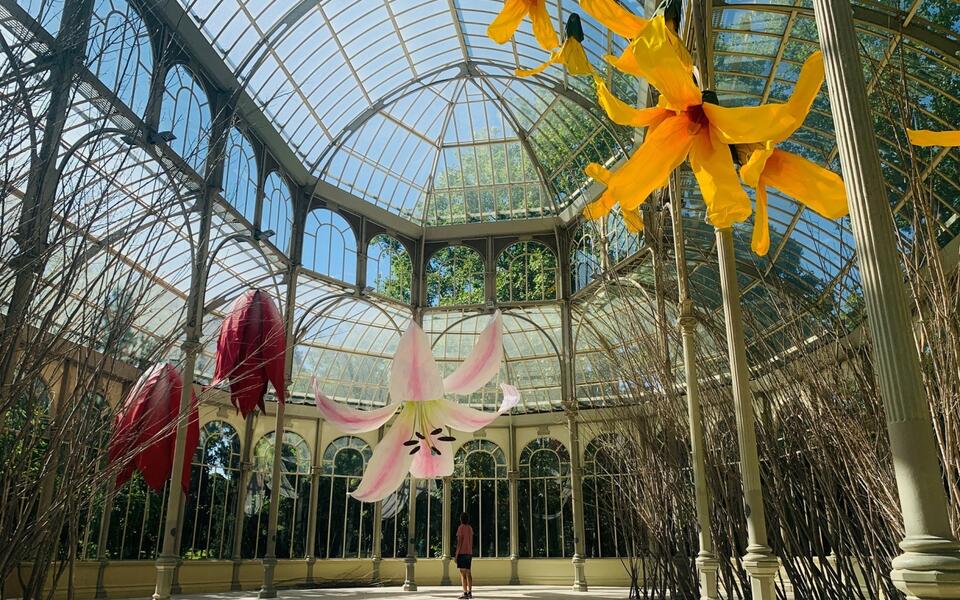TO A RAVEN AND HURRICANES THAT FROM UNKNOWN PLACES BRING BACK SMELLS OF HUMANS IN LOVE
The Reina Sofia Museum presents "To a raven and hurricanes that from unknown places bring back smells of humans in love", the first solo exhibition of Petrit Halilaj (Kostërrc, Kosovo, 1986) in Spain. The exhibition, with large-scale installations, is located in the Palacio de Cristal.

The work of Petrit Halilaj is tightly bound up with his biography, the recent history of his country, and the consequences of the political and cultural tensions in the region. Childhood memories steeped in the drama of war and refugee life recur throughout his art, which embraces themes like home, nation and cultural identity through a variety of media ranging from drawing and sculpture to video, installation and even writing. However, he does not proclaim a rupture between the personal and intimate and the historical and social, but instead perceives a relationship and continuity to be found in his intervention for the Palacio de Cristal.
-
Vista de la exposición Petrit Halilaj. A un cuervo y los huracanes que, desde lugares desconocidos, traen de vuelta olores de humanos enamorados, Palacio de Cristal, 2020. ImagenSubliminal (Miguel de Guzmán + Rocío Romero)
-
Vista de la exposición Petrit Halilaj. A un cuervo y los huracanes que, desde lugares desconocidos, traen de vuelta olores de humanos enamorados, Palacio de Cristal, 2020. ImagenSubliminal (Miguel de Guzmán + Rocío Romero)
-
Vista de la exposición Petrit Halilaj. A un cuervo y los huracanes que, desde lugares desconocidos, traen de vuelta olores de humanos enamorados, Palacio de Cristal, 2020. ImagenSubliminal (Miguel de Guzmán + Rocío Romero)
-
Vista de la exposición Petrit Halilaj. A un cuervo y los huracanes que, desde lugares desconocidos, traen de vuelta olores de humanos enamorados, Palacio de Cristal, 2020. ImagenSubliminal (Miguel de Guzmán + Rocío Romero)
Perhaps that is why for this show he was half-jokingly and half-seriously invited to produce “the piece of his life”. Halilaj seems to have taken the proposal almost literally, making artistic material out of his biographical experience. He has turned the Palacio de Cristal into a giant nest that connects the interior with the exterior, linking visitors to their surroundings by opening windows, installing structures, and setting up feeding areas to attract the birds and other creatures inhabiting or transiting through Parque del Retiro. Birds, a recurrent feature of his work, symbolize the transgression of the limits established by modern thought between subject and object, culture and nature. In particular, the artist has drawn inspiration from the extraordinary courtship ritual of bowerbirds, which make elaborate structures (‘bowers’) and decorate them with colorful objects to attract a mate. The idea of this ritual is closely linked to his biography. The large flowers which decorate the nest, made of a delicate steel framework and painted canvas, are the result of collaborative work with his life partner, the artist Álvaro Urbano. Their choice forms part of the personal history that binds them together, and its purpose is to celebrate their union: forsythia, palm seeds, cherry blossom, poppy, carnation, and lily. However, these references are far from remaining mere anecdotes. In being made public, their intimacy acquires an evident social and political dimension. This call for visibility and acceptance becomes even more relevant when we recall the Palacio de Cristal’s colonial past as a place of exhibition and exclusion, together with its function as a public space.
-
Vista de la exposición Petrit Halilaj. A un cuervo y los huracanes que, desde lugares desconocidos, traen de vuelta olores de humanos enamorados, Palacio de Cristal, 2020. ImagenSubliminal (Miguel de Guzmán + Rocío Romero)
-
Vista de la exposición Petrit Halilaj. A un cuervo y los huracanes que, desde lugares desconocidos, traen de vuelta olores de humanos enamorados, Palacio de Cristal, 2020. ImagenSubliminal (Miguel de Guzmán + Rocío Romero)
-
Vista de la exposición Petrit Halilaj. A un cuervo y los huracanes que, desde lugares desconocidos, traen de vuelta olores de humanos enamorados, Palacio de Cristal, 2020. ImagenSubliminal (Miguel de Guzmán + Rocío Romero)
-
Vista de la exposición Petrit Halilaj. A un cuervo y los huracanes que, desde lugares desconocidos, traen de vuelta olores de humanos enamorados, Palacio de Cristal, 2020. ImagenSubliminal (Miguel de Guzmán + Rocío Romero)
-
Vista de la exposición Petrit Halilaj. A un cuervo y los huracanes que, desde lugares desconocidos, traen de vuelta olores de humanos enamorados, Palacio de Cristal, 2020. ImagenSubliminal (Miguel de Guzmán + Rocío Romero)
Like nests in nature, the space devised by Halilaj cannot be regarded as autonomous or separate from its environment, its visitors, and their activities. On the contrary, it is a continuation of them. This relationship, which can be understood as a form of interdependence, resounds throughout the installation. Moreover, there is something strange and disproportionate about the size of this nest, the gigantic scale of its flowers, and the comfort and centrality it offers the birds. The artist thus suspends the logocentric perspective that makes us believe we are the center and measure of all things, encouraging us to recognize ourselves as just one more element among many. The nest is thus revealed as the setting for a ritual that lies in wait for encounters, alliances and unions among its different visitors, altering and changing with the space.




